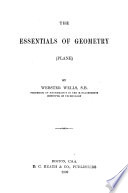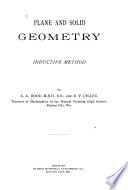 | James Howard Gore - Geometry - 1898 - 232 pages
...terms are in proportion. PROPOSITION IX. THEOREM. 209. In a series of equal ratios, any antecedent is to its consequent as the sum of all the antecedents is to the sum of all the consequents. Let a : b = c : d = e : f. To prove a + c + e:b + d +/= a : b = c : d = e : f. Let r be the value of... | |
 | Webster Wells - Geometry - 1898 - 264 pages
...From(l), o_ = c- (§ 237) ac and o^-ft^Cj-d. ac PROP. VIII. THEOREM. 240. In a series of equal ratios, the sum, of all the antecedents is to the sum of all the consequents as any antecedent 18 to its consequent. Given a:b = c:d=e:f. (1) To Prove a + c + e:b + d +/= a : b.... | |
 | Arthur A. Dodd, B. Thomas Chace - Geometry - 1898 - 468 pages
...: W~C'*— CD : C' D' . Now substitute these values in your first equations. By proportion, §198, the sum of all the antecedents is to the sum of all the consequents as any antecedent is to its consequent. Can you write an equation so that the sum of the AS in the... | |
 | Webster Wells - Geometry - 1899 - 424 pages
...bc — d .: a + b: a — 6 = c + d:c — d. PROP. VIII. THEOREM. 240. In a series of equal ratios, the sum of all the antecedents is to the sum of all the consequents as any antecedent is to its consequent. Given a:b = c:d = e:f. (1) To Prove a + c + e :b + d+f= a:... | |
 | George Egbert Fisher - Algebra - 1900 - 438 pages
...b : c, we have, by Art. 8, &2 = ac ; whence b = 19. In a series of equal ratios, any antecedent is to its consequent as the sum of all the antecedents is to the sum of all the consequents. Let % : d¡ = пi : d? = пя : d3 — ••• = v, П, Wo îi, or -. = v, ~ = v, -f = v, — . di... | |
 | George Egbert Fisher - 1901 - 622 pages
...have, by Art. 8, W = ас ; whence b = -¡/(ac). 19. In a series of equal ratios, any antecedent is to its consequent as the sum of all the antecedents is to the sum of all the consequents. Let n, : (2j = nt : d2 = Wj da = ••• = v, Then n1 = vd¡, n<i = vd2, n3 = vds, • ••. Ad... | |
 | James Harrington Boyd - Algebra - 1901 - 812 pages
...?^*. [{491] ac By dividing (1) by (2), 2-±| = e-±± 493. THEOREM IX. — In a series of equal ratios the sum of all the antecedents is to the sum of all the consequents as any one antecedent is to its consequent. Let the 'ratios be (1) j- = J- = ± = = r. (2) a = Ar,... | |
 | James Harrington Boyd - Algebra - 1901 - 818 pages
...= e=± [1491] ac By dividing (1) by (2), J±| = ^ 493. THEOREM IX. — In a series of equal ratios the sum of all the antecedents is to the sum of all the consequents as any one antecedent w to its consequent. Let the ratios be (1) •£• = -£• = £ = ..... = r.... | |
 | Thomas Franklin Holgate - Geometry - 1901 - 462 pages
...h.-.R, or - = ^-^, that P:R = hm: kn. ' kn R kn' 240. THEOREM. If any number of ratios are equal, then the sum of all the antecedents is to the sum of all the consequents as any one antecedent is to its consequent. Let a^ : 6! = 02 : 62 = a3 : 63 = •••. It is required... | |
 | James Howard Gore - Geometry - 1902 - 266 pages
...are in proportion. PROPOSITION IX. THEOREM. 209. In a series of equal ratios, any antecedent is to Us consequent as the sum of all the antecedents is to the sum of all the consequents. Let a:b = c:d=e:f. To prove a + c + e:b + d +f= a:b = c:d = e:f. Let r be the value of the equal ratios,... | |
| |